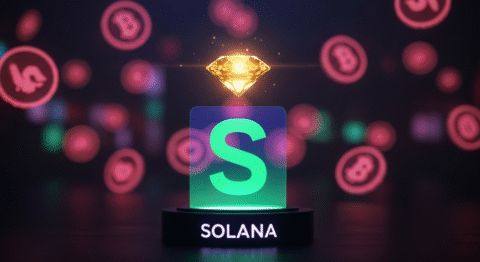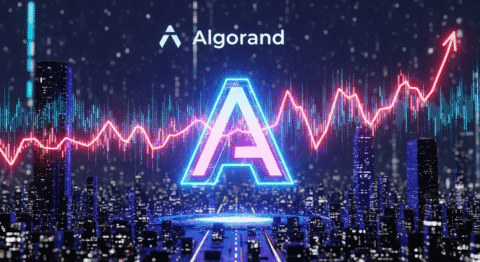In the dynamic and often unpredictable world of cryptocurrency, where fortunes are made and lost in the blink of an eye, a new breed of digital asset has captured the imagination of millions – meme coins. But beneath the playful exteriors and viral marketing campaigns, lies a complex ecosystem with its own set of rules, risks, and rewards. Have you ever wondered what separates a fleeting trend from a lasting digital phenomenon? Today, we dive deep into the heart of this phenomenon, specifically exploring Doge Killer,
The Crypto Market Snapshot: A Sea of Altcoins and Emerging Trends
The cryptocurrency market is a constantly evolving landscape, and understanding its current state is crucial for any investor, particularly those looking at the altcoin sector. As of late, we’ve witnessed a significant resurgence in altcoin activity, driven partly by Bitcoin’s price stability and the growing interest in the decentralized finance (DeFi) space. Data from blockchain analytics firm Glassnode indicates a notable increase in the number of active addresses for various altcoins, suggesting broader network participation and usage.
Meme coins, while often dismissed by traditional finance enthusiasts, have carved out a significant niche. Their market capitalization, though volatile, represents billions of dollars, demonstrating a substantial investor base interested in their unique appeal. Looking at market trends, we see a pattern of rapid adoption followed by periods of consolidation, a characteristic that underscores their speculative nature. Furthermore, the recent surge in interest around airdrops – the distribution of free cryptocurrency tokens – signals a continued emphasis on community building and token distribution for new projects.
The Core Concept: Deconstructing the Meme Coin Phenomenon
To truly understand the appeal and mechanics of projects like Doge Killer, we must first grasp the fundamental concepts of altcoins and, more specifically, meme coins.

What Are Altcoins / Meme Coins / Airdrops?
Altcoins
Altcoins, short for “alternative coins,” are any cryptocurrencies that are not Bitcoin. They emerged as developers sought to improve upon Bitcoin’s perceived limitations or explore new blockchain functionalities. Altcoins can range from utility tokens designed to power decentralized applications, to stablecoins pegged to fiat currencies, to sophisticated smart contract platforms enabling complex transactions. Their diversity is their strength, offering a vast array of use cases and technological innovations.
Meme Coins
Meme coins are a sub-category of altcoins that often derive their name, branding, and community from internet memes or popular culture references. While they might lack the deep technological underpinnings of some other altcoins, their success is heavily reliant on community engagement, social media virality, and strong marketing. Early examples like Dogecoin and Shiba Inu paved the way, demonstrating that a strong community can propel a token’s value significantly, often detached from traditional fundamental analysis. The appeal lies in accessibility, community participation, and the potential for rapid, albeit risky, gains.
Airdrops
Airdrops are a common marketing and distribution strategy for new cryptocurrency projects. They involve distributing a certain amount of tokens to multiple cryptocurrency wallet addresses, usually free of charge. This is often done to promote a new coin, increase brand awareness, reward existing holders of a particular cryptocurrency, or incentivize users to interact with a new blockchain or dApp. Airdrops can be a fantastic way for new and existing crypto users to acquire tokens without direct purchase, though they often come with conditions like holding another specific token or performing certain social media tasks. They are a powerful tool for community growth and early token distribution, often setting the stage for future price movements.
Key Components & Technologies
The underlying technology for most altcoins, including meme coins, is blockchain technology. Blockchain provides a decentralized, immutable ledger that records all transactions. This ensures transparency, security, and the integrity of the token’s supply and transaction history.
For meme coins specifically, several technologies and features are commonly observed:
- Smart Contracts: Often built on platforms like Ethereum or Binance Smart Chain (BSC), meme coins utilize smart contracts to automate token creation, distribution, and transaction logic. These contracts define the rules of the token, such as its total supply, how it can be transferred, and any potential burning mechanisms or reward distributions.
- Decentralized Finance (DeFi) Integration: Many meme coins aim to integrate with the DeFi ecosystem, allowing users to stake their tokens for rewards, provide liquidity to decentralized exchanges (DEXs), or participate in yield farming. This integration can provide utility beyond speculative trading.
- Community Governance (DAOs): Some meme coin projects are moving towards Decentralized Autonomous Organizations (DAOs), where token holders can vote on proposals related to the project’s development, marketing, and future direction. This fosters community ownership and engagement.
- Token Burning Mechanisms: To combat inflation and potentially increase scarcity, many meme coins implement token burning. This involves permanently removing tokens from circulation, often by sending them to a dead wallet, which can, in theory, drive up the value of the remaining tokens.
Understanding these components helps to differentiate between projects with genuine utility and those that are purely speculative.
The Data-Driven Perspective: Unpacking Market Performance
To make informed decisions in the volatile crypto markets, a data-driven approach is paramount. Let’s examine the market data and tokenomics surrounding meme coins and their potential.
Market Data & Trends
The meme coin market, while appearing chaotic, exhibits discernible trends. Data from CoinMarketCap and CoinGecko consistently shows that meme coins, despite their often-volatile nature, have attracted significant trading volume. For instance, during market rallies, meme coins frequently outperform broader market trends, albeit with higher beta (sensitivity to market movements).
Recent analysis indicates a shift in investor sentiment. While early meme coins relied heavily on hype, newer projects are attempting to incorporate more utility, such as DeFi integrations, NFT marketplaces, or specific ecosystem applications. This evolution is reflected in rising trading volumes for tokens associated with these more advanced functionalities. Furthermore, the increasing adoption of decentralised exchanges (DEXs) has also fueled meme coin growth, as these platforms offer easier listing and trading for newer, community-driven tokens without the stringent requirements of centralized exchanges.
Consider the surge in interest around the LEASH coin. Its performance has been closely watched, with data suggesting significant price movements often driven by community sentiment and news surrounding its associated ecosystem development. Analyzing its trading volume, market cap, and the number of holders can provide insights into its growing adoption rate and potential future trajectory. While past performance is not indicative of future results, understanding these metrics offers a glimpse into the market’s reaction to such assets.
Tokenomics & Market Health
Tokenomics refers to the economic model of a cryptocurrency, encompassing its supply, distribution, utility, and mechanisms for value accrual. For meme coins, tokenomics can be highly varied and often designed to incentivize holding and community participation.
- Supply: Meme coins can have vastly different total supplies. Some, like Dogecoin, have an uncapped supply, leading to inflationary pressures. Others, like Shiba Inu, have a massive initial supply that is subject to burning mechanisms. Doge Killer, for example, has a defined tokenomics structure that needs careful examination. Understanding whether the supply is fixed, inflationary, or deflationary is crucial for assessing long-term value.
- Distribution: How tokens are initially distributed—through presales, public sales, airdrops, or team allocations—significantly impacts decentralization and potential for manipulation. A wide distribution among many holders is generally seen as healthier.
- Utility & Value Accrual: Does the token have a clear use case within its ecosystem? Does holding it offer rewards, governance rights, or access to services? Tokens that can demonstrate utility and a clear path to value accrual are more likely to sustain their price beyond speculative hype. For instance, if Doge Killer offers staking rewards or grants access to exclusive features within its platform, these elements can contribute to its market health.
- Transaction Fees & Taxes: Some meme coins implement transaction fees, a portion of which might be redistributed to existing holders (reflection tokens), sent to a liquidity pool, or burned. While this can incentivize holding, high transaction taxes can deter trading activity.
Analyzing these tokenomic factors for Doge Killer and comparing them with similar projects is essential for assessing its long-term viability and market health. A project with well-thought-out tokenomics that aligns with its community-driven ethos is more likely to withstand market volatility and achieve sustainable growth.
Risks, Challenges & Competition
Every investment in the cryptocurrency space comes with inherent risks, and meme coins are no exception. Understanding these is critical for responsible investing.
Risks of Altcoins and Meme Coins
- Extreme Volatility: Meme coins are notoriously volatile. Their prices can skyrocket due to social media trends or celebrity endorsements, only to crash dramatically just as quickly. This makes them high-risk investments, suitable only for those with a high-risk tolerance.
- Lack of Intrinsic Value: Many meme coins start with little to no fundamental utility. Their value is primarily driven by speculation and community sentiment. If the hype dies down or a new meme captures the public’s attention, the value can evaporate.
- Security Vulnerabilities: Smart contracts, while powerful, can be prone to bugs or exploits. A vulnerability in the underlying code can lead to significant losses. Audits by reputable third-party security firms are crucial but not always a guarantee of complete safety.
- Regulatory Uncertainty: The regulatory landscape for cryptocurrencies, especially meme coins, is still evolving. Governments worldwide are grappling with how to classify and regulate these assets. Adverse regulatory actions could significantly impact their value and legality.
- Pump-and-Dump Schemes: The speculative nature of meme coins makes them prime targets for “pump-and-dump” schemes, where a group artificially inflates the price of a token before selling off their holdings, leaving other investors with significant losses.
How Does Doge Killer Stack Up Against Competitors?
To understand Doge Killer‘s position in the market, it’s essential to compare it with other prominent meme coins and potentially utility-focused altcoins.
| Feature | Doge Killer | Dogecoin (DOGE) | Shiba Inu (SHIB) | Other Utility Altcoins |
|---|---|---|---|---|
| Origin | Meme-driven, community-focused. | Internet meme, early cryptocurrency. | Internet meme, positioned as “Dogecoin Killer.” | Varies (DeFi, NFTs, Web3 infrastructure, etc.) |
| Utility | Focus on ecosystem development, potential utility features (needs verification). | Primarily a peer-to-peer payment system, limited DeFi integration. | Ecosystem development (Shibarium, NFTs, Metaverse), DeFi potential. | Clearly defined use cases, often powering specific platforms or services. |
| Tokenomics | Specific supply, burning mechanisms, potential deflationary aspects (details vary). | Uncapped supply, inflationary. | High initial supply, significant burning mechanisms planned/ongoing. | Varies greatly, often designed for specific ecosystem functions. |
| Community | Strong focus on community engagement and growth. | Large, established, and loyal community. | Massive, highly active, and meme-driven community. | Varies greatly, often tied to a specific project’s vision. |
| Risk Profile | High (as with most meme coins), potential for high reward offset by high risk. | Moderate to High. | High, subject to significant volatility. | Varies from moderate to very high, depending on project maturity and utility. |
| Competitor Advantage | Unique community focus, specific utility roadmap. | Longevity, brand recognition, established payment functionality. | Strong community engagement, growing ecosystem development. | Established utility, proven use cases, potentially more stable growth. |
This comparative approach highlights that while Doge Killer likely taps into the potent force of community and meme culture, its long-term success will hinge on its ability to deliver on its promised utility, manage its tokenomics effectively, and navigate the competitive landscape of both meme coins and more established altcoins. The presence of assets like the LEASH coin within its ecosystem or as strategic partners can further influence its competitive edge and market perception.
The Future Outlook: What’s Next for Meme Coins and Doge Killer?
The trajectory of meme coins and altcoins is inextricably linked to broader market trends and technological advancements in blockchain. Predicting the future with certainty is impossible, but we can identify key drivers shaping the landscape.
What’s Next for Altcoins / Meme Coins / Airdrops?
- Increased Utility and Real-World Application: The days of purely speculative meme coins might be numbered. Projects that can demonstrate tangible utility, integrate with DeFi protocols in meaningful ways, or offer unique experiences (like gaming or metaverse integration) are more likely to survive and thrive. Expect a stronger emphasis on utility-driven meme coins.
- Enhanced Community Governance: As DAOs become more prevalent, meme coin communities will likely play an even larger role in decision-making. This can foster greater loyalty and ensure projects align with the desires of their token holders.
- Regulatory Clarity: As governments establish clearer regulations, the crypto market, including meme coins, will adapt. This could lead to greater institutional adoption but also potential restrictions on certain types of tokens or activities.
- Focus on Sustainability: The energy consumption concerns surrounding some blockchains might push the meme coin sector towards more energy-efficient networks (like those using Proof-of-Stake).
- Sophistication in Marketing: While meme culture will remain central, expect more sophisticated marketing strategies that blend viral trends with educational content and demonstrable value propositions. Airdrops will continue to be a key tool for engaging new users and rewarding existing communities.
- Integration and Interoperability: As the blockchain space matures, projects that can interoperate with other blockchains and protocols will gain a significant advantage. Doge Killer, by potentially integrating with or utilizing the infrastructure of tokens like the LEASH coin, could leverage this trend.
For Doge Killer, the path forward will likely involve solidifying its ecosystem, building out its promised utilities, and continuously engaging its community. Whether it can transition from a hyped meme coin to a sustainable digital asset with lasting value will depend significantly on its development team’s execution and its ability to adapt to the evolving market.
Conclusion: Navigating the Meme Coin Frontier
Doge Killer represents a fascinating case study in the evolution of meme coins. It embodies the power of community, the allure of viral marketing, and the persistent search for value in the decentralized digital economy. We’ve explored its roots within the broader altcoin and meme coin landscape, delved into its underlying technologies, dissected its tokenomics, and weighed its risks against its potential.
The cryptocurrency market is a dynamic arena, and while meme coins offer the thrilling prospect of rapid gains, they also demand a thorough understanding of their inherent volatility and speculative nature. For newcomers, starting with smaller investments and educating oneself thoroughly is paramount. For seasoned traders, integrating meme coin plays into a diversified strategy, with a keen eye on tokenomics and community health, can be a path to potential rewards.
What are your thoughts on Doge Killer? Do you believe it has the potential to disrupt the meme coin space? What other meme coins are on your radar? Share your insights in the comments below! If you found this deep dive into Doge Killer valuable, be sure to explore our other articles on altcoins, DeFi strategies, and the latest airdrop opportunities. Subscribe to our newsletter for regular updates and expert analysis to keep you ahead of the curve in the ever-changing world of crypto.
Frequently Asked Questions
Q1: What is a meme coin in cryptocurrency?
A1: A meme coin is a type of cryptocurrency that often derives its name, branding, and community from internet memes or pop culture. While they may have some underlying technology, their value is heavily influenced by social media trends, community engagement, and speculative interest, rather than fundamental utility alone.
Q2: Is Doge Killer a legitimate cryptocurrency?
A2: Doge Killer is a legitimate cryptocurrency project that has gained significant attention. However, like all meme coins, its perceived legitimacy and future value are subject to market sentiment, community support, and the project’s actual development and adoption. It’s important to conduct thorough research and understand the risks involved.
Q3: What are the risks of investing in meme coins like Doge Killer?
A3: The primary risks include extreme price volatility, the potential lack of intrinsic value or utility, security vulnerabilities in smart contracts, regulatory uncertainty, and the susceptibility to pump-and-dump schemes. It’s crucial to invest only what you can afford to lose.
Q4: What is the difference between an altcoin and a meme coin?
A4: An altcoin is any cryptocurrency other than Bitcoin. Meme coins are a sub-category of altcoins that are primarily characterized by their meme-based branding and community-driven hype. While all meme coins are altcoins, not all altcoins are meme coins.
Q5: How do airdrops work, and are they related to Doge Killer?
A5: Airdrops are a method of distributing free tokens to cryptocurrency wallet holders, often as a marketing strategy or to reward community members. While the specifics of Doge Killer‘s airdrop strategy would need to be confirmed through its official channels, many meme coin projects utilize airdrops to build their community and distribute their tokens.
Q6: Where can I research the tokenomics of Doge Killer?
A6: You can typically find detailed information about Doge Killer‘s tokenomics on its official website, whitepaper, or reputable cryptocurrency data aggregators like CoinMarketCap or CoinGecko. Always refer to official sources for the most accurate and up-to-date information.






